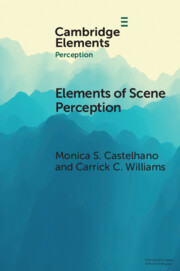72 results
Crossing the cultural bridge: The role of inhibitory control during second language metaphor comprehension
-
- Journal:
- Bilingualism: Language and Cognition , First View
- Published online by Cambridge University Press:
- 19 February 2025, pp. 1-17
-
- Article
-
- You have access
- Open access
- HTML
- Export citation
Learning Irony in School: Effects of Metapragmatic Training
-
- Journal:
- Journal of Child Language , First View
- Published online by Cambridge University Press:
- 18 February 2025, pp. 1-22
-
- Article
-
- You have access
- Open access
- HTML
- Export citation
Chapter 46 - Ataxia
- from Section 4: - Dyscoordinative and Otherwise Inappropriate Motor Behaviors
-
-
- Book:
- International Compendium of Movement Disorders
- Published online:
- 07 January 2025
- Print publication:
- 06 February 2025, pp 568-591
-
- Chapter
- Export citation
Modeling Eye Movements During Decision Making: A Review
-
- Journal:
- Psychometrika / Volume 88 / Issue 2 / June 2023
- Published online by Cambridge University Press:
- 01 January 2025, pp. 697-729
-
- Article
-
- You have access
- Open access
- HTML
- Export citation
Do reading times predict word learning? An eye–tracking study with novel words
-
- Journal:
- Studies in Second Language Acquisition / Volume 46 / Issue 4 / September 2024
- Published online by Cambridge University Press:
- 04 November 2024, pp. 1282-1297
- Print publication:
- September 2024
-
- Article
-
- You have access
- Open access
- HTML
- Export citation
Eye movements as a tool to investigate exemplar retrieval in judgments
-
- Journal:
- Judgment and Decision Making / Volume 19 / 2024
- Published online by Cambridge University Press:
- 26 February 2024, e8
-
- Article
-
- You have access
- Open access
- HTML
- Export citation
Cognate facilitation in bilingual reading: The influence of orthographic and phonological similarity on lexical decisions and eye-movements
-
- Journal:
- Bilingualism: Language and Cognition / Volume 27 / Issue 5 / November 2024
- Published online by Cambridge University Press:
- 24 January 2024, pp. 964-981
-
- Article
-
- You have access
- Open access
- HTML
- Export citation

The Psychology of Reading
- Insights from Chinese
-
- Published online:
- 04 January 2024
- Print publication:
- 18 January 2024
Evolution of the visual system in ray-finned fishes
-
- Journal:
- Visual Neuroscience / Volume 40 / 2023
- Published online by Cambridge University Press:
- 20 December 2023, E005
-
- Article
-
- You have access
- Open access
- HTML
- Export citation
Bidirectional cross-linguistic influence with different-script languages: Evidence from eye tracking
-
- Journal:
- Applied Psycholinguistics / Volume 44 / Issue 5 / September 2023
- Published online by Cambridge University Press:
- 11 April 2023, pp. 635-667
-
- Article
- Export citation
Competition between form-related words in bilingual sentence reading: Effects of language proficiency
-
- Journal:
- Bilingualism: Language and Cognition / Volume 26 / Issue 2 / March 2023
- Published online by Cambridge University Press:
- 07 October 2022, pp. 384-401
-
- Article
- Export citation
Stages of sight translation: Evidence from eye movements
-
- Journal:
- Applied Psycholinguistics / Volume 43 / Issue 5 / September 2022
- Published online by Cambridge University Press:
- 12 September 2022, pp. 997-1018
-
- Article
-
- You have access
- Open access
- HTML
- Export citation
The effect of frequency of exposure on the processing and learning of collocations: A comparison of first and second language readers’ eye movements
-
- Journal:
- Applied Psycholinguistics / Volume 43 / Issue 3 / May 2022
- Published online by Cambridge University Press:
- 04 May 2022, pp. 727-756
-
- Article
-
- You have access
- Open access
- HTML
- Export citation
Insights from real-time comprehension of Spanish verbal tense in children with developmental language disorder: An eye-tracking study
-
- Journal:
- Applied Psycholinguistics / Volume 43 / Issue 3 / May 2022
- Published online by Cambridge University Press:
- 03 March 2022, pp. 641-662
-
- Article
-
- You have access
- Open access
- HTML
- Export citation
Why subtitle speed matters: Evidence from word skipping and rereading
-
- Journal:
- Applied Psycholinguistics / Volume 43 / Issue 1 / January 2022
- Published online by Cambridge University Press:
- 03 December 2021, pp. 211-236
-
- Article
- Export citation
The impact of audio on the reading of intralingual versus interlingual subtitles: Evidence from eye movements
-
- Journal:
- Applied Psycholinguistics / Volume 43 / Issue 1 / January 2022
- Published online by Cambridge University Press:
- 03 December 2021, pp. 237-269
-
- Article
- Export citation
Knowledge is a river and education is like a stairway: An eye movement study on how L2 speakers process metaphors and similes
-
- Journal:
- Bilingualism: Language and Cognition / Volume 25 / Issue 2 / March 2022
- Published online by Cambridge University Press:
- 08 November 2021, pp. 307-320
-
- Article
-
- You have access
- Open access
- HTML
- Export citation

Elements of Scene Perception
-
- Published online:
- 06 October 2021
- Print publication:
- 11 November 2021
-
- Element
- Export citation
An eye-tracking study for measuring the attentional characteristics towards emotional scenes in children with autism spectrum condition
-
- Journal:
- European Psychiatry / Volume 64 / Issue S1 / April 2021
- Published online by Cambridge University Press:
- 13 August 2021, pp. S226-S227
-
- Article
-
- You have access
- Open access
- Export citation
3 - Cognition
-
- Book:
- Chess and Individual Differences
- Published online:
- 03 December 2020
- Print publication:
- 17 December 2020, pp 19-37
-
- Chapter
- Export citation


